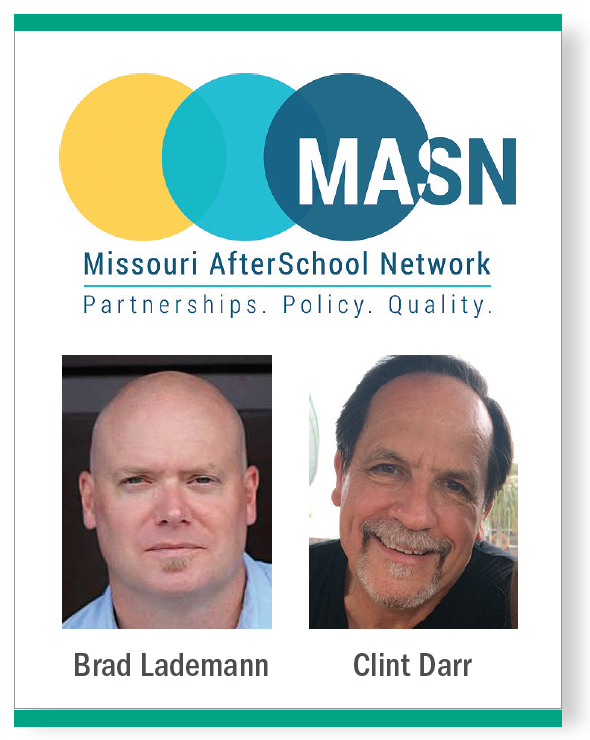By Marion Baldwin, Senior TA Consultant, American Institutes for Research
In 2016, training for afterschool programs was transformed in Missouri when Brad Lademann and Clint Darr from the Missouri Afterschool Network (MASN) held their first Beyond the Bell® Toolkit training for 21st Century Community Learning Centers (21st CCLC) grantees from small, rural Missouri school districts.
Lademann and Darr, certified Beyond the Bell trainers in Columbia, Missouri, support school-, faith-, and community-based organizations that provide quality experiences and learning opportunities for youth and families outside traditional school hours. Using the Beyond the Bell Toolkit, MASN, with support from the Missouri Department of Elementary and Secondary Education, provides technical assistance for nearly 200 programs in Missouri. We caught up with Lademann and Darr to find out how they do it.

As the coordinator for MASN’s Afterschool Resource Center, it is Lademann’s job to ensure that all school-age children, youth, and families in Missouri have access to high-quality, sustainable afterschool programs. Darr and seven others at MASN are afterschool regional educators (AREs) who are professional trainers with a wide variety of experience; these AREs include past program directors and certified teachers. They are the boots on the ground providing direct support to programs. Lademann and Darr say the resources in the Beyond the Bell Toolkit opened up a new world for their work and for the program staff who have participated in their trainings.
Since completing the Beyond the Bell Toolkit training-of-trainers in 2015, they have incorporated Toolkit resources into their work with “all stages of programs whether existing, start up, or potential afterschool programs.” They offer full-day trainings based on the content of the Toolkit to support potential programs in figuring out what afterschool might look like in their community, steer practitioners to resources based on their needs, and help new programs establish a solid foundation for high-quality implementation. Lademann and Darr have found the Beyond the Bell Toolkit to be a great resource for any afterschool program regardless of its funding, and when approaching potential afterschool programs, the Toolkit is great for community building.
Lademann and Darr have found the Toolkit to be a great resource for any afterschool program regardless of its funding.
“So often, you go to a training and bring back resources that simply sit on the shelf,” Darr said. That is not the case with the Beyond the Bell Toolkit. Lademann and Darr found the structure of the Toolkit to be very user friendly, mentioning how the color coding makes it easy to navigate. They also said the flexibility of being able to customize the materials gives them a training resource that offers something for everyone. The stand-alone sections of the Toolkit often are used during their trainings to help participants think through issues that their programs face, such as scheduling, implementing a high-quality program, or developing and branding programs for elementary, middle, and high school students, and the ready-to-use tools can be personalized to best meet program needs.
They aim to make their training sessions very conversational to encourage networking. For example, they open the trainings with icebreakers to connect people in the room. Following icebreakers, they ask, “Why afterschool?” And they use Afterschool Alliance slides and data, especially with new programs, to tell the afterschool story to superintendents, funders, community partners, and to make connections. (See the Alliance’s Research page for data on afterschool benefits, and its interactive map for afterschool state data.) Next, they use the scavenger hunt activity from the Beyond the Bell Toolkit training-of-trainers to help demystify the Toolkit. They provide a problem template, give trainees the opportunity to discover the Toolkit on their own, and guide training participants as needed. Lots of conversation happens at this time. After training, AREs connect with programs one-on-one to discuss their individual grant goals and what program quality looks like; together, as partners, they celebrate afterschool program successes as they strive constantly to improve program quality based on best practices.

When asked to use one word to describe how he feels about his work, Lademann said “blessed.” Lademann, who served as a youth pastor for 10 years, also has provided afterschool programming for middle schoolers, served as an afterschool program leader and site coordinator, and worked with troubled youth. His work history includes experience with 21st CCLC, School Age Community, and Communities in Schools programs. As for Darr, he used the word “fulfilled” to describe his feelings about his work. Prior to MASN, Darr was an elementary school teacher for 14 years. When he left the classroom, he became a full-time afterschool site facilitator; there, he found his calling.
The Missouri AfterSchool Network is hosted by the University of Missouri Extension’s 4-H Center for Youth Development, with funding from the C.S. Mott Foundation and the Missouri Department of Elementary and Secondary Education.



